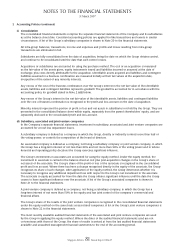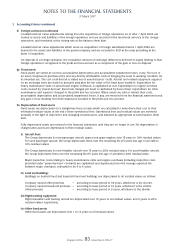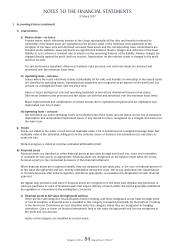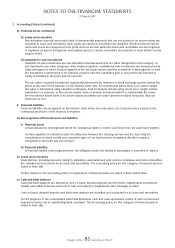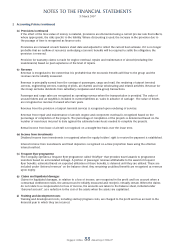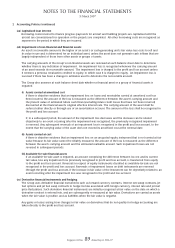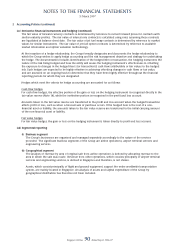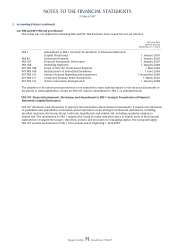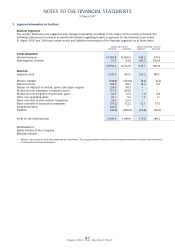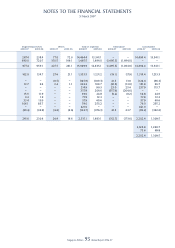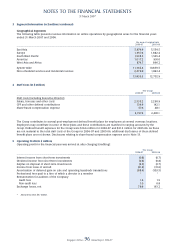Singapore Airlines 2007 Annual Report Download - page 91
Download and view the complete annual report
Please find page 91 of the 2007 Singapore Airlines annual report below. You can navigate through the pages in the report by either clicking on the pages listed below, or by using the keyword search tool below to find specific information within the annual report.Singapore Airlines 89 Annual Report 2006-07
NOTES TO THE FINANCIAL STATEMENTS
31 March 2007
2 Accounting Policies (continued)
(aa)
Capitalised loan interest
Borrowing costs incurred to fi nance progress payments for aircraft and building projects are capitalised until the
aircraft are commissioned for operation or the projects are completed. All other borrowing costs are recognised as
expenses in the period in which they are incurred.
(
ab
)
Impairment of non-fi nancial and fi nancial assets
An asset’s recoverable amount is the higher of an asset’s or cash-generating unit’s fair value less costs to sell and
its value in use and is determined for an individual asset, unless the asset does not generate cash infl ows that are
largely independent of those from other assets or groups of assets.
The carrying amounts of the Group’s non-fi nancial assets are reviewed at each balance sheet date to determine
whether there is any indication of impairment. An impairment loss is recognised whenever the carrying amount
of an asset exceeds its recoverable amount. The impairment loss is charged to the profi t and loss account unless
it reverses a previous revaluation credited to equity, in which case it is charged to equity. An impairment loss is
reversed if there has been a change in estimates used to determine the recoverable amount.
The Group also assesses at each balance sheet date whether a fi nancial asset or a group of fi nancial assets is
impaired.
(i) Assets carried at amortised cost
If there is objective evidence that an impairment loss on loans and receivables carried at amortised cost has
been incurred, the amount of the loss is measured as the difference between the asset’s carrying amount and
the present value of estimated future cash fl ows (excluding future credit losses that have not been incurred)
discounted at the fi nancial asset’s original effective interest rate. The carrying amount of the asset shall be
reduced either directly or through use of an amortisation account. The amount of the loss shall be recognised in
the profi t and loss account.
If, in a subsequent period, the amount of the impairment loss decreases and the decrease can be related
objectively to an event occurring after the impairment was recognised, the previously recognised impairment
is reversed. Any subsequent reversals of an impairment loss is recognised in the profi t and loss account, to the
extent that the carrying value of the asset does not exceed its amortised cost at the reversal date.
(ii) Assets carried at cost
If there is objective evidence that an impairment loss on an unquoted equity instrument that is not carried at fair
value because its fair value cannot be reliably measured, the amount of the loss is measured as the difference
between the asset’s carrying amount and the estimated realisable amount. Such impairment losses are not
reversed in subsequent periods.
(iii) Available-for-sale fi nancial assets
If an available-for-sale asset is impaired, an amount comprising the difference between its cost and its current
fair value, less any impairment loss previously recognised in profi t and loss account, is transferred from equity
to the profi t and loss account. Reversals in respect of equity instruments classifi ed as available-for-sale are not
recognised in the profi t and loss account. Reversals of impairment losses on debt instruments are reversed
through the profi t and loss account, if the increase in fair value of the instrument can be objectively related to an
event occurring after the impairment loss was recognised in the profi t and loss account.
(ac)
Derivative fi nancial instruments and hedging
The Group uses derivative fi nancial instruments such as forward currency contracts, interest rate swap contracts, jet
fuel options and jet fuel swap contracts to hedge its risks associated with foreign currency, interest rate and jet fuel
price fl uctuations. Such derivative fi nancial instruments are initially recognised at fair value on the date on which a
derivative contract is entered into, and are subsequently re-measured at fair value. Derivatives are carried as assets
when the fair value is positive, and as liabilities when the fair value is negative.
Any gains or losses arising from changes in fair value on derivatives that do not qualify for hedge accounting are
taken directly to the profi t and loss account.




